Connotation and Denotation, Term Paper Example
Abstract
Human connection is often understood to exist because of one particular matter, communication. Communication is the process by which humans utilize words [both spoken and not] to relate to another. The exchange of responses between individuals conversing often creates an indicative condition by which one is able to establish connection with another. However, not all connections are positive. This means that not all relationships that are established through communication ends up properly and could be regarded as positive. Why is this so? The utilization of words and the process by which these words are given meaning often defines the condition of development that a human relationship based on communication is able to undergo. It is for this reason why it is important how denotation and connotation are both used in the process of giving meaning to words that are used in conversations. The exchange of ideas between human individuals could either create negative or positive response based on how the listener intends to accept the message that is being sent to him by the speaker.
The paper that follows shall give an indicative discussion and explanation on what denotation and connotation are, what their differences are and how the collaborative utilization of their principles would actually improve the process by which humans give meanings to words that they use in communicating with others. Through this discussion, it is expected that the utilization of both aspects of language-determination would help in improving communication and the aspect of interpretation that listeners use as they handle the need to understand and explain what words mean especially when they are used in practical terms of communication in the society.
Introduction
Words have been utilized for so many years for one particular reason, to communicate. Humans have been used to expressing themselves in several different manners. However, when it comes to specifically relating to others what they feel, they utilize communication to connect with others in the community. Words were necessary for such procedure and for several years, humans were able to develop different forms of word groups they used to communicate to one another. Such aspects of relative connections indicated a good sense of creating new communities, establishing social identities (Nichols, 1984, 97) and furthering the manner by which people utilize words to express themselves and define who they really are as they connect with others in the society.
Background of Issue
In relation to how words are utilized in communication and sending message, two particular procedures are undertaken, one is that of denotation and another is connotation. In studying the manners by which humans developed a way of giving meaning to words, denotation and connotation play a key role in refining the understanding over the most crucial points of communication that humans engage with. In the course of deciphering how words come into existence (Martinet, 2000, 15), how they developed and how much value they have in relation to developing human communications, it is important to consider the meaning and definition of the procedures of connotation and denotation. Understanding how the said aspects of ‘giving meaning’ to words will provide a foundation on identifying the real worth of words as they are used in different manners to communicate ideas towards others.
Research Process Approach
In the discussion that shall be considered in this research, several aspects of communication shall be given attention to in relation to what denotation and connotation means. Exploring the different elements of these two procedures are and how they are used to communicate thoughts and ideas is expected to make this presentation more relatively practical especially in understanding how words define the human capacity to express and relay themselves to others (Halliday, et al, 2006, 78). Along with such concentration, a focus on the positive and negative aspects of ‘giving meaning’ that affects the integrity of human communication shall also be given attention to. In light of the need to define words and how they may up the general manner by which humans communicate, denotation and connotation shall be expressed in different manners that specifically allow the readers to take note on how they use both aspects of ‘giving meaning’ in their own process of communicating with others.
To be able to handle the broadness of the topic at hand, this research shall be subdivided into several sections with an aim to focus on particular aspects of denotation connotation, one turn at a time hence allowing for a more clarified definition of each element making up the discussion. Notably, such approach is hoped to manifest a condition of properly established topical presentation that would be easier for the readers to relate to especially in consideration with how the topic reflects their own way of communicating with others.
What is Denotation?
Giving meaning
Words are formed by letters that are defined alongside the phonetics that connect them altogether; however, when it comes to the meaning of such elements put together, there are different forms by which humans tend to understand a word. When it comes to the process of giving meaning through denotation, it is defined as something that gives direct meaning to a matter. Notably, such accounts for the actual elements that could be used to define something. Words that are given meaning through denotation depend on the actuality of the matter which means that somehow, the physical attributes, anything that could be easily seen by the eyes, heard by the ears or anything that could be directly defined through the five senses becomes the foundation of giving meaning through denotation (Greenberg, 1999, 140). Direct, concise and specifically easy to understand and particularly unchangeable, the denotation of a word is also noted as the word’s actual meaning as it is.
Aspects Affecting Meaning
Since this process of giving meaning appeals to the five sense of the body, there are only a few reasons that might affect the meaning of a word through denotation. One would be that of the physical inability of one to utilize one or more of the five senses, which may or may not affect the ways by which a person understands the actual meaning of a word (Chomsky, 1998, 113). For instance, if an individual has been blind from birth and a hot air balloon would be defined to him based on the visual characteristics of the matter, it would perhaps be hard for him to easily accept what is being described to him until he is actually able to touch the it and visualize how it looks like based on how he feels it.
The materialization of a word being described is the primary characteristic of how denotation occurs. The ways by which a dictionary defines a word is an actual example of denotation. There are no added meanings that are based from human opinion when it comes to the presentation of the denoted meaning of a word. The descriptions are most often than not undeniable and cannot be argued upon as they are based on actual characteristics of the matter that the word intends to refer to (Halliday, et al, 2006, 88). The word “rose” may be described as a flower usually colored red, pink or white that grows in tropical climate. The description of the matters that the words refer to could be as expandable as possible. The meanings may define the characteristics of the matter at first glance to actually defining their scientific attributes. Nevertheless, the actuality of the said descriptions needs to be direct and specific making them unchangeable unless the matter being described changes through time. This is the reason why when it comes to the revision of dictionaries, very few alterations on word definitions are made as the descriptions are as specific as they are and cannot be changed unless the matter described incurs specific alterations.
What is Connotation?
Giving meaning
The description of a word under the process of connotation takes a more complex approach than that of the aspect of word-meaning followed through denotation. In the process of giving meaning to a word through connotation, it is important that the one giving meaning does not use what is evident or what is specifically obvious about the matter. Instead, it deals more with the process of deciphering the inner meaning of a word. It poses the need to see more than what is actually described; to explore different aspects of possibilities that may be related to the word and how it is viewed by the person aiming to describe it. Unlike the undeniable and unchangeable descriptions gained through denotation, connotation often deploys different points of meaning depending on the person that is aiming to make a distinctive description of something (The American Heritage Dictionary of the English Language, 2000). For instance, a rose [as an example used in the presentation of denotation] may appeal to one as a symbol of love, while to another person it may present a symbol of passion. How one deciphers the meaning of a word or a matter through connotation is affected by fundamental elements that are evidently creating a specific impact on the way one understands a word. In a way, connotation is more dependent on the perception of the individual regarding the deeper meaning of a particular word.
Aspects Affecting Meaning
Since connotation is dependent on perception, more aspects affect the meaning of a word in line with this particular process of giving meaning. These elements include the following:
Experience: when an individual experiences something, that experience stays intact in mind. Relatively, such memory is accessed depending on the demand of the current situation that a person becomes involved with. For instance, if a person was able to climb a very high mountain in the past, seeing a mountain at present may remind him of the exhaustion and the achievement that he has felt during the time when he first climbed a mountain. It is for this reason that mountains have also been likened to specific mountain-like challenges that humans need to get over with [as if climbing each step towards the peak part of the said location].
Biases: when it comes to gender-defined issues, women often view a specific matter differently from men. Due to the differences on perceiving matters because of their genders, men and women often define matters differently (Halliday, et al, 2006, 89). An example of such is that of the establishment of particular marketing campaigns for axe. Axe is a prominent product in the market, its use of the term “sexual attraction” may mean as it is to men, however, to women, it may simply mean stronger appeal that attracts their attention [not necessarily sexual in condition]. Nevertheless, since the product is dedicated to men, the marketers of the item intend to utilize the meaning that appeals more to the male population in the market.
Stereotypes: One particular aspect of stereotyping may include discrimination of races between human individuals. The superiority of other races compared to other skin colors may affect how one defines a specific matter that is related to a specific race. One example of this is that of the connotation of black African Americans relatively connoted to be “slaves”. Although there is a truth about this matter, especially relating to the past records of history, stereotyping modern African Americans who have the same free will as that of the other races would be inappropriate thus is imposed to be discouraged among human individuals today.
Perceptions : What one thinks may be right may be wrong on another’s eyes. When it comes to social norms and traditions, there are instances when individuals view the same situations differently (Halliday, et al, 2006, 91). This specific connotation of the matter depends on the personal perception of an individual based on his beliefs and the conditions by which he was brought up to. A poor person may see a piece of carton to be a possible part of his protective roof on a dilapidated hand-made house that he tries to establish for his family. However, for a rich man, such carton is nothing but waste. The statute of one in life may as well intervene in the manner by which he perceives something as a part of his being or at least as a part of the society he is living in.
Emotions: Sensitivity over a matter may affect how one gives meaning to a word. The word “love” may mean differently to two women who have had different experiences with their partners in life. The one having a more positive experience on love with her husband may see ‘love’ as something that is fulfilling, a matter that fills the void of one’s emptiness. On the other end, if a woman had a tiring and rather abusive relationship with her husband in the past, then the word ‘love’ may have a more negative implication on her making her react more differently from others who see the positive value of the word ‘love’. In this case, experience again plays a great role in identifying the emotional bearing that a person has towards a certain matter. That emotional pattern that has been established then creates an intervening approach that influences the thinking that a person has towards a certain word that relates to the situation that he or she may have been involved with in the past (Greenberg, 1999, 144).
Negative and Positive Connotation
While there are aspects that directly affect how one connotes the meaning of a word, the resulting end of the process of giving meaning influences the condition by which one becomes attached or detached to a word. Among the factors that affect the resulting connotation of a word are as follows [these specific aspects of differentiation in giving meaning to words often create friction between people engaging in conversation that involves the said matters of understanding words as they are being said]:
Attitudinal Perception: in defining the character of a person, there are always two sides to one mirror. One is that of the good side of it and another is the not-so-good angle of the image (Berko, et al, 2010, 9). Every individual has his or her own good and bad side depending on the behavior that the person is more accustomed to. When it comes to communicating with others, such attitudinal perception creates more than just a sense of understanding on what another person is saying. It leaves a deep mark depending on how one receives what is being said. For example, a person with a patient attitude may perceive the meaning of the words that comes out from the mouth of another to be a mere representation of how that one person feels thus is not necessarily directed towards him whenever unpleasant words come out from the other. On the other end, a person who is suspicious may view the situation differently hence assuming that every word, negative or positive, that comes out from another is assumed to be directed towards him thus resulting to negative retaliations which could later on develop to massive arguments. This is the primary reason why it is often suggested that in communication, the utilization of the right words at the right time should be given full attention to (McMahon, 1994, 1994), especially in consideration with the attitudinal differences of the ones involved in the conversation.
Going Overboard: What one does not say often implies more than what comes out of the mouth; in a conversation, the one at the listening end has a choice (McMahon, 1994). It depends on him whether or not he is going to receive the message being presented to him by the speaker in a positive manner. Depending on the aspects of experience and history, there are instances when a listener may go overboard what is being said by the speaker. For instance, the speaker may have said “there will be a party at my place”, the listener [being a close friend of the speaker] perceives the matter as a boring occasion to be held in another boring place. This meaning has been garnered due to the fact that he might have already been to several parties that has been hosted by the speaker in the past. In this case, others who may not know the speaker may think that the word “party” means fun and exciting. This however is because of the fact that they do not know the one speaking nor do they have any inkling about his personality and his understanding with regards parties.
Personality and Profiling: When one who has authority over a matter is saying something, what he says immediately becomes reliable without any doubt. For example, when a weatherman reports in the news that it would rain the next day, 75% of the listeners often believe on the matter hence motivating them to bring rain gears when they go out the next morning. However, the same message presented by the weatherman would not have the same impact if it was uttered by a teacher of philosophy or law. The command that a person has over a field of interest makes it easier for him to be believed by the people (Heyman, 1994, 134). Profiling is a process that listeners often use to decide whether or not to believe what is being said by a particular speaker.
Integrity and Characteristic of Speaker: What is the character and the identifiable being of the speaker? This particular matter affects so much the manner by which the listeners perceive whatever one says. For instance, a president of a nation who has been accused to corruption in the past will have lower chance of being believed by the people compared to a president whose name has been clean ever since the time he took over the administration. This then provides a differential level of trust that the people have towards what the said individuals might say in relation to national interest. The public, being the constant listeners to prominent individuals [such as presidents] in the society had reservations on whether or not to believe what they hear (Akmajian, et al, 2010, 112). For a man who has been upright in the eyes of the people, every word he says becomes the truth, however a man who had a dented slate in his name may be viewed differently by the people.
Non-verbal meaning: the aspect of facial expression and body language says so much about words that are never uttered (Chomsky, 1998, 113). If a man says ‘I love you’ to a woman, without even looking in her eyes may be assumed by the woman to be lying or somewhat insincere about the matter. In this case, it is not the words that are being measured by the listeners, but the manner by which each word is uttered by the speaker.
Considering the different aspects that affect the provision of connotation on a word, it could be analyzed that unlike denotation which is often dependent on defining a word as it is, connotation takes a different path. Instead of looking through the word alone, the process of connotation as an aspect of giving meaning insists on the need to include the other words that come along with the one that has to be defined. In a way, this indicates the need to see the meaning of a word according to ‘context’ (Chomsky, 1998, 115). The group of words used alongside one word may imply several different meanings (McMahon, 1994, 19). This is the reason why when describing a word through connotation, listeners or readers often see the meaning of other words presented alongside the one in focus. Phrase-based meaning then becomes an important key towards providing viable connotations to particular words used in speech.
The Connection between Connotation and Denotation
It is realized that through research, denotation and connotation of words work together as a collaborative way of identifying the value of a certain term. This is why a single word may have different meanings depending on the field that it is being related to. The term ‘clear’ may mean differently to those working with justice law [where ‘clear’ may refer to the conscience of an accused who has been perceived not guilty by the court] in contrast with those handling interior arrangements [where ‘clear’ may mean a well-lighted place or somewhat a clean area of the location being arranged.
In communication, it always occurs that denotation of words occur first. The word ‘stop’ may mean stop as it is when the one at the listening end perceives it as a command (Akmajian, et al, 2010, 115). However, when the listener expands the meaning of the said word depending on the reaction and expression of the speaker, the uttered term may mean ‘shut up, I do not want to listen to you’ or ‘stop what you are doing, I do not like it’. The expansion of terms based on how one sees the expression of the speaker or how the speaker himself uttered the words he used to send his message might largely influence the result of the conversation.
From the example provided above, it could be noted how conversations intend to either intensify or decrease the emotional bearings of particular words depending on how one progresses to use the aspect of word-connotation from merely giving meaning through denotation (McMahon, 1994, 19). In this case, it is obvious how words that might have simple meanings could impose stronger messages depending on how the speaker delivered the message or on the other end how the listener perceived what was being said. Specifically considering what the speaker would want to say then depends on how the listener decides to decipher or decode each word that is being used in the process of communication.
To further describe the relation between denotation and connotation, here is a brief illustration on how the distinction of giving meaning to words based on these two different approaches is handled:
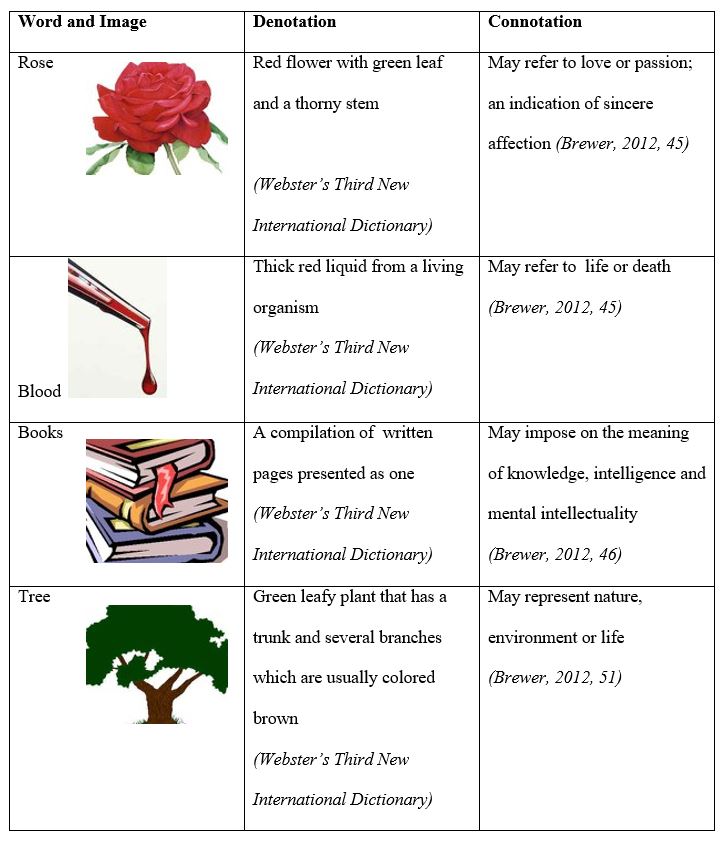
True, the effective use of denotation and later on connotation in a conversation could improve the manner by which two or more people connect towards each other through communication. However, if the utilization of denotation and connotation has been handled in a negative aspect then somehow, the process of communication could be considered a failure. With the many factors affecting the manner by which words are given meaning through connotation, its use as a form of defining words or phrases is assumed to have the need to be subjected to more conscious considerations especially in relation to weighing the differences and the uniqueness between listeners and speakers in specific conversations (Halliday, et al, 2006, 92).
The Role of Connotation and Denotation in Communication
With the different ways to communicate, humans utilize both denotation and connotation of words in a collaborative manner. As a medium of sending message, there are several manners by which both ways of giving meaning are being utilized in the society today. Some of the said manners include the following:
Practical Conversation
Communication is also often defined as a manner of conversation. May it involve two or more people exchanging thoughts and ideas, a conversation often imposes on the capacity of a the speaker/s to send message and perhaps even influence the thinking of the listener/s. The words utilized by the speaker/s are chosen depending on the topic being discussed and the people being talked to. In practical conversation, denotation of the meaning of the words used in speaking helps the listeners to directly identify what is being said (Halliday, et al, 2006, 98). However, when it comes to understanding the real worth of the speech that has been presented or that has been uttered, then the utilization of giving meaning through connotation comes in handy. In a way, in practical conversations, the process of denotation assumes the capacity of the listeners to hear the words and know what they mean as they are, however when connotation comes in, a deeper sense of deciphering the meaning of the words is required (Clarke, 1990, 143). Sometimes, personal reflection is even suggested so as to get the gist of a speech that has been released for the sake of sending a meaning that has undergone a certain course of connotation.
Literary Analysis
From classical to modern literature, denotation and connotation play a great role in creating different worlds from the different worded art that writers have produced through the years. In terms of the classical era, literary writers are often accustomed to utilizing words that describe their emotions, their surroundings, their history or whichever topic they might want to present in their writing (Clarke, 1990, 143). These words may have a direct indication on their case. For instance, flowers have been used to define the vast array of vegetation in the past, however, not only did the flowers represent the actual vegetation, instead, they also represented particular elements relating to feminism and the emotion that comes along with it.
Considerably, in the field of literature, there are several instances when the same element is used over and over again and yet have different meanings every time they are used. For example, the word “mountain” in the single literary creation entitled “The Magic Mountain” by Thomas Mann, the author utilized both the denotation and the connotation of the said word to represent his message to his readers. In here, he describes the mountains of Germany as it is [noting the use of denotation of the word ‘mountain’] (Clarke, 1990, 144). He presents how the grand scenery in Germany is most often than not covering the vast array of the said location. Relatively, such condition in the nation is known worldwide thus creating interest upon the readers of the novel. On the other hand, the same author used the same word to describe the different challenges that Germany and its people had to deal with during the World War Eras (Clarke, 1990 144). Notably, Germany and the people thriving in it had to withstand several ‘mountains of being dismayed and disappointed through the war years’ especially when it comes to defining the path of progress that the country and its people desire to take.
Today, the utilization of both denotation and connotation on single literary works by new writers continue to influence the field of literature. Around the globe, the same practice is embraced to give deeper and more recognizable value for the readers to contemplate with (Halliday, et al, 2006). The aspect of connotation on this end however is much more given value. This is the reason why at present, even the classical novels are used as tools of analysis for academic requirements. The reason behind this is that at some point, the meaning of one written work alone changes through time depending on how the new generation assumes about the meaning of the said written piece. The attention placed upon the interest of the readers on such written works through time creates a massive indication that written art lives longer than expected due to the existence of connotation. With the changing situations of time, the people perceive old and new stories differently (Martinet, 2000, 15). Depending on their personal understanding of the words used to represent the ideas that the authors wanted to convey, these stories, novels, poems and other forms of literature gain different meanings from particularly different readers coming from different ages and generations.
Society and Politics
When it comes to social issues, politics is most often than not considered to be the most crucial one especially that it involves the utilization [and sometimes the exploitation] of social interest (Petrilli, 2009, 353). In this case, it should be recognized that politicians are well-noted for their effective use of words especially during the campaign season. The manifestation of such expertise often is regarded especially in the manner by which they convince the people to believe them and their agenda of administrative governance.
Take for example the current rivalry between Romney and Obama as the primary candidates for Presidency in the American government. Both candidates have a detectable political background that they could be proud of. Both are also noted to have the capacity to govern based from their experiences and their past records. However, what the public wants to know is how they are going to handle themselves in front of a mock public interview during the debates that they engaged in during the campaign season. In each state that they visit, they are asked several questions about the economy, education, health and other social issues that concern the American communities across the country (Danesi, 2007). The manners by which they are able to answer such queries create a valuable matter in their process of campaign thus creating an implicative notion of interest on the part of the people who are to vote them in position. To present an example of such form of proper utilization of words during the campaign of the two candidates mentioned, below are some quotable words from the said individuals during the campaign debate:
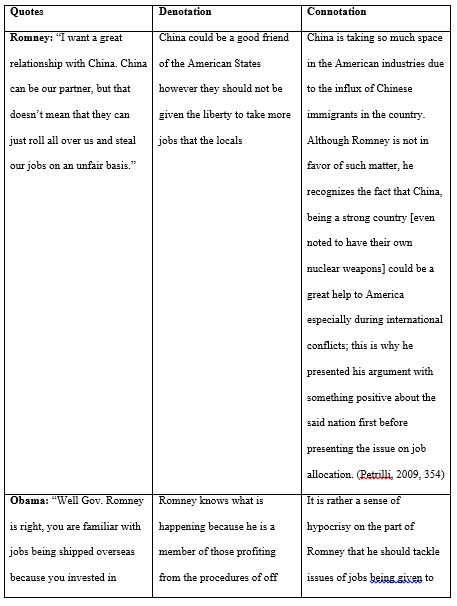
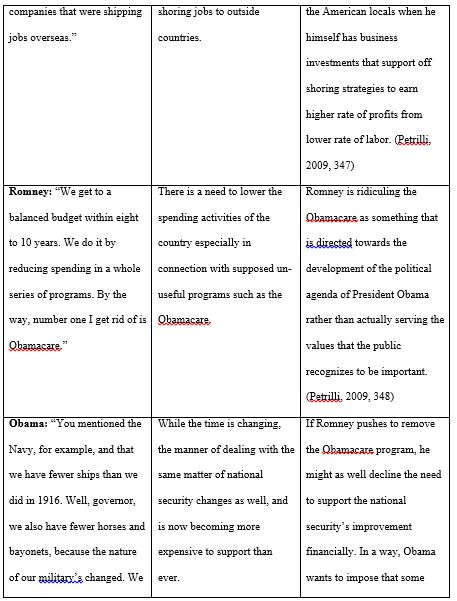
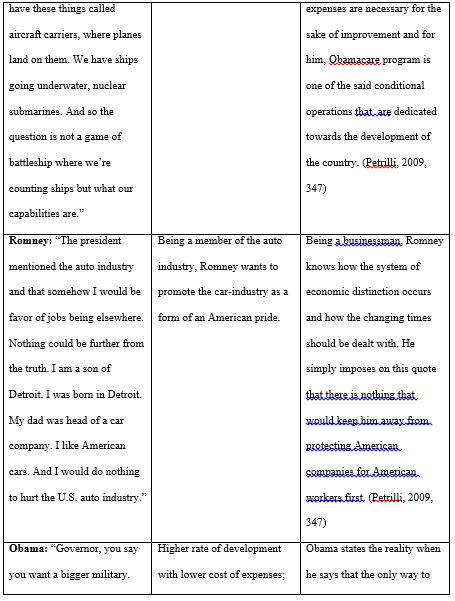
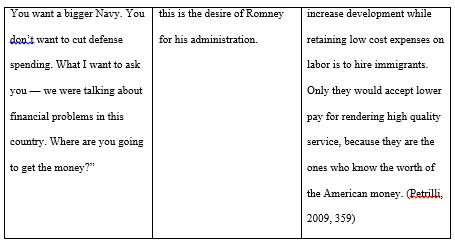
Source for quotes: PFPD, 2012, worldwide web)
Observe from the given examples herein how the candidates tried to convince their listeners through aiming to deface the other. Nevertheless, it is the content of their responses to the issues concerning America that was considered valuable by the listeners. How each one tried to defend their position on each matter creates a sense of distinction on how they would face the country’s problems when they are already seated in position. Take note how the connotation of the quotes specifically impose on what the speakers think of their opponent and how they want to convey such personal perception towards the listening public. The eradication of hidden meanings show how each candidate aims to create a sense of disappointment on the part of the listeners towards their opponent (Danesi, 2007). Bringing about some historical records about their opponent gives them the opportunity to show how they are going to deal with the matter differently so as to create more valuable solutions for the country and its people along with the other nationalities that are looking towards the helping hand of the American society.
Marketing and Business
Businesses communicate with their target market through marketing. It is through this process that they are able to create a sense of realization among their target clients especially in relation to the need to escalate the interest that the market has towards buying their products and accepting their services (Dev, et al, 2005, 14). Marketing procedures however could be tricky. The complexity of the use of words in this course of influencing the society involves the need to create a sense of attraction for the society to give attention to (Greenberg, 1999, 144). Appealing to their demands and the emotional bearings they have upon certain matters that are important to them, the business industries try to gain the attention of the market through making an impact on their perceptive views about life as a whole (Chomsky, 1998, 120). The reason behind the success of effective marketing campaigns involves the utilization of emotional value that humans often respond to. Depending on the market sector that the organizations want to influence, the ads created for marketing are often fashioned towards the desires and emotional bearings of their target clients. Here are some of the examples of such ads and the denotation and connotation of their meaning to the market as well:

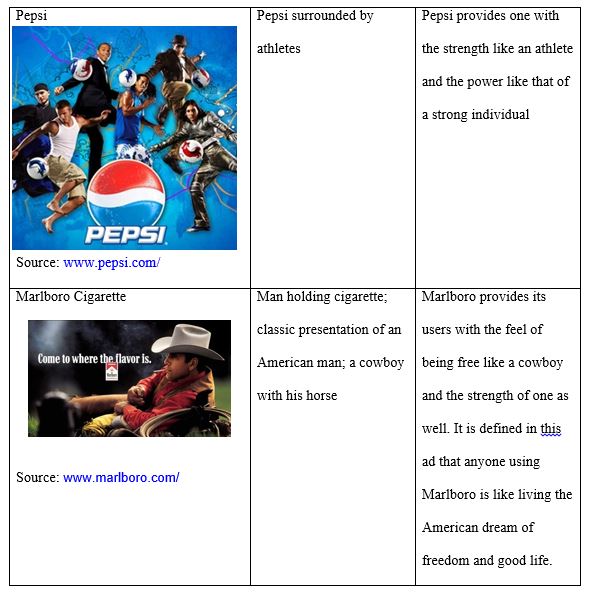
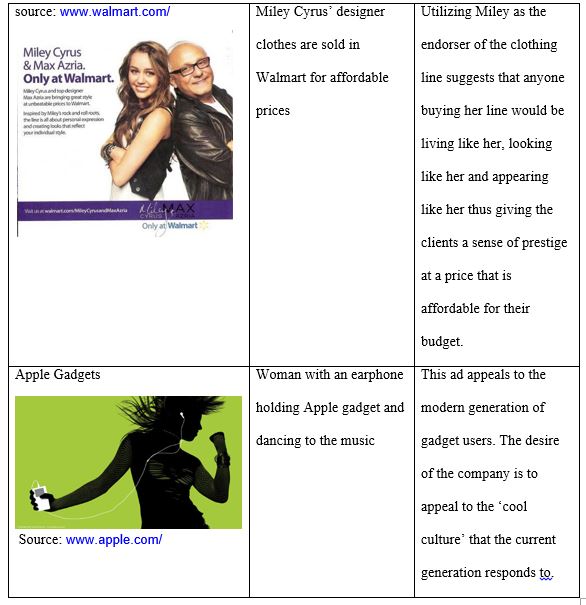
The photo ads presented in this section of the discussion creates a distinctive condition by which the companies try to appeal to what their clients want through creating visual presentations that are suggestive and have underlying meanings. Although some of the photo ads do not have words in them, their suggestive representation of the idea they would want to send to their clients is vivid enough to get the attention of those whom they want to influence.
Conversational Idioms
Regular conversations in English often involve the utilization of idioms especially when the speaker wants to relate a certain issue or matter to another. This means that the speaker wants to create an insistence on what he wants to convey to the listener. These are often referred to as the process by which one uses several phrases to define a meaning that would be much effective than using the actual words that describe the matter. Here are some examples of idioms usually used in common conversations in English:
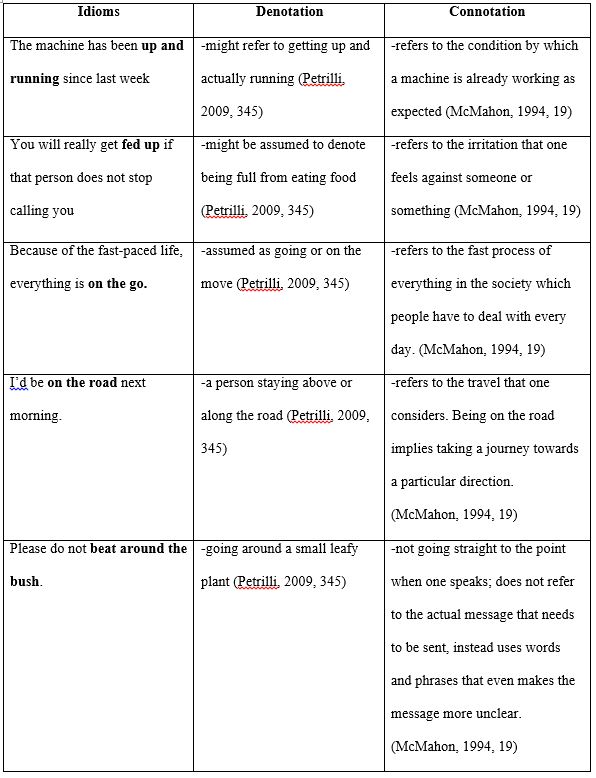

Source of Idioms Used: ESL, 2012, worldwide web
Take note from the examples of the idioms used in general and common conversation that denotation of the words and their meanings often result to senseless indications of message. It is in this case that connotation works towards the condition by which the message of a certain group of words are interpreted as pertaining to a single indication of meaning alone. Relatively, the denoted meaning helps in relating the situation to the actual message being sent by the speaker, however taking the said words as directly as they mean would not help in the process of decoding the actual message being conveyed through the said group of words.
Reflections and Learning
From the discussion presented herein, it could be noticed how denotation and connotation are both utilized as forms of defining grounds for words that are imposed in several factors of human communication. May the communication be structured or not, denotation and connotation both work together to create a direct and a deeper meaning that would create a more meaningful message for each uttered word. The examples that were used show that denotation of words used in conversation and communication often cannot be refuted because of their being direct and certain. Relatively though, in the aspect of creating a connotation on the meaning of words, the diversification of interpretation could depend on several factors that humans consider to be strongly relative to their emotions, beliefs and personal perceptions.
In the field of modern communications, politics and marketing, both aspects of giving meaning to words are being used effectively to gain attention from the public. In a world of information and presentation, it is essential for the public listeners to be able to interpret messages sent to them clearly. This further imposes on the need to be more careful in being influenced to do or buy something that the majority suggests. Words are often used as tools of persuasion especially in the field of business and politics. Being able to understand the connotation behind such presentations is an important aspect of communication at the listener’s end thus creating for them a better source of defense for matters that are hypocritical and unreal.
True, it has been learned from the context of this discussion that the utilization of words to influence others is indeed a great tool used then and now by the different sectors of the society. The assumption of meaning on these words largely creates a strong impact on how people decide, how they analyze and how they see through different situations that they become engaged with. The world of commerce and politics are only two among the many other social entities that utilize words and their meanings to define the path by which they are to attract the public in joining their mission or responding to their invitation (Greenberg, 1999, 142). The manner by which one responds to the said matters would depend on how much he is able to effectively use the process of connotation that is far from simply giving the denoted meaning of words used in a message.
Conclusion and Recommendation
Humans respond to messages differently because of the different backgrounds they develop regarding certain matters presented to them. The discussion presented in this research gives a proof that the meaning of words changes depending on the interpretation of the listeners. Truthfully, such matter becomes real at the process of involving word-connotation. Denotation on the other hand is the primary aspect of giving meaning to words used in a speech or conversation. With the application of denotation, a word gains first hand interpretation that becomes the basis of further understanding that is developed through applying the process of giving connotation to specific words in specific passages. It has been considered herein that unlike denotation, connotation of words often involve the consideration of the contextual meaning of a term. This way, the term could be better defined according to how it has been used in a sentence or a phrase. In deciphering such meaning, a listener or a reader uses different aspects that most often than not relate to personal interpretation basing from his experience and the history that binds the word being defined. At this point, it could then be realized that the reason behind the different meanings of words to different people become possible due to the indicative application of giving meaning through connotation.
References
Akmajian, Adrian; Demers, Richard; Farmer, Ann; Harnish, Robert (2010). Linguistics: An Introduction to Language and Communication. Cambridge, MA: The MIT Press.
Barnlund, D. C. (2008). A transactional model of communication. In. C. D. Mortensen (Eds.), Communication theory (2nd ed., pp47-57). New Brunswick, New Jersey: Transaction.
Berko, Roy M., et al.(2010). Communicating. 11th ed. Boston, MA: Pearson Education, Inc., 2010) 9-12.
Brewer, Cobham. (Latest Edition of 2012). Brewer’s Dictionary of Phrase and Fable. Chambers Harrap Publishers.
Clarke, David S. (1990). Sources of semiotic: readings with commentary from antiquity to the present. Carbondale: Southern Illinois University Press. pp. 143–144.
Chomsky, Noam (1998). “Three Models for the Description of Language”. IRE Transactions on Information Theory 2 (2): 113–123.
Danesi, Marcel. (2007). The Quest for Meaning: A Guide to Semiotic Theory and Practice. Toronto: University of Toronto Press.
Dave, Sperling. ESL Idioms. http://www.eslcafe.com/idioms/id-b.html. (Retrieved November 12, 2012).
Dev, Chekitan S.; Don E. Schultz (January/February 2005). “In the Mix: A Customer-Focused Approach Can Bring the Current Marketing Mix into the 21st Century”. Marketing Management 14 (1).
Greenberg, Joseph (1999). “Linguistics and ethnology”. Southwestern Journal of Anthropology 4: 140–47.
Halliday, Michael A. K.; Jonathan Webster (2006). On Language and Linguistics. Continuum International Publishing Group. p. vii.
Heyman, Richard. (1994). Why Didn’t You Say That in the First Place? How to Be Understood at Work. 1st. San Francesco, Ca: Jossey-Bass Inc. Print.
Johnson, Samuel. (Since 1755). A Dictionary of the English Language. Richard Bentley Publication.
McMahon, A. M. S. (1994). Understanding Language Change. Cambridge University Press. p. 19.
Martinet, André (2000). Elements of General Linguistics. Tr. Elisabeth Palmer (Studies in General Linguistics, vol. i.). London: Faber. p. 15.
Nichols, Johanna (1984). “Functional Theories of Grammar”. Annual Review of Anthropology 13: 97.
Petrilli, S. (2009). Semiotics as semioethics in the era of global communication. Semiotica, 173(1-4), 343-347, 353-354, 359.
“Denotation”. The American Heritage Dictionary of the English Language. Houghton Mifflin Harcourt. 2000.
“Connotation”. The American Heritage Dictionary of the English Language. Houghton Mifflin Harcourt. 2000.
Politico. Final presidential debate: Obama, Romney best quotes. http://www.politico.com/news/stories/1012/82726_Page2.html. (retrieved on November 7, 2012).
Sperling, Dave. ESL Idioms. http://www.eslcafe.com/idioms/id-b.html. (Retrieved November 12, 2012).
Webster’s Third New International Dictionary. The American Heritage Dictionary of the English Language. Houghton Mifflin Publishing: Boston.

Time is precious
don’t waste it!

Plagiarism-free
guarantee

Privacy
guarantee

Secure
checkout

Money back
guarantee






